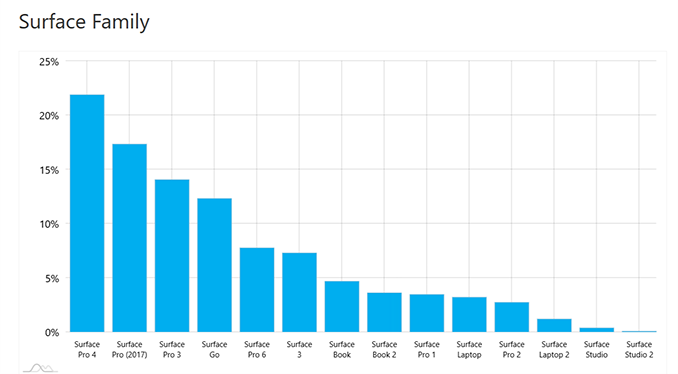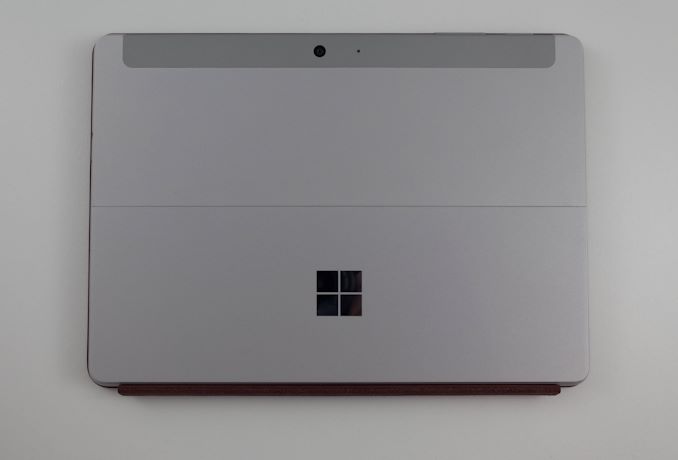The Microsoft Surface Go LTE Review: Unmatched Mobility
by Brett Howse on January 17, 2019 8:00 AM ESTFinal Words
The Surface Go sits in a somewhat interesting segment of the market. The base model has a price that’s low enough to be considered a value proposition, but like all value devices, there’s compromise to get there. The $399 starting price includes just 4 GB of RAM, and 64 GB of eMMC storage, which is outright the bare minimum that would even be usable with Windows 10. Microsoft now offers a 4 GB model with the 128 GB SSD for $499, which is already a price that’s creeping out of the value segment. 8 GB of RAM is $549, which is a lot for a low-end device. If you want to add LTE, the price starts at $679 with 8 GB of RAM and 128 GB of storage, and business customers will be able to purchase a 256 GB model as well. Then you must add in the price of the Type Cover, which starts at $99, and is realistically a required accessory.
A model with 8 GB of RAM and the Type Cover is therefore about $650, or a bit more if you choose a Signature Type Cover. That’s a lot more than the $399 get-you-in-the-door price, and really moves the Surface Go up a couple of rungs on the pricing ladder.
But the Surface Go does have some very good qualities going for it. The build quality is certainly a step above anything else in this price range on the PC side, with a fantastic magnesium body, a built-in kickstand which is every bit as good as the Surface Pro’s, and a very light weight. Even with the Type Cover attached, the device still only weighs 767 grams, or about 1.7 lbs, and coupled with the small size, makes the Surface Go extremely portable. Add in the fact that it works with the Surface Pen, and you can see an easy use case in a small, but expensive, note taking machine.
Microsoft also color calibrates all of its displays, and you would be hard pressed to find anything else in the PC space at this price range with as accurate of a display. The Go’s display isn’t the highest density one around, but at 216 pixels-per-inch, it still offers great clarity, and good contrast as well. Microsoft offers better displays on some of its other devices, but this is still a high quality display and very pleasing to use.
However, there’s some drawbacks as well. At the introductory price of $399, the underwhelming performance fits in with much of the competition, where Intel’s Atom is the name of the game. Despite Microsoft moving to a Core-based Pentium in the Surface Go, it’s disappointing to see where it stacks up: more or less even in terms of CPU performance with Intel’s latest Atom processor. At $399, that’s kind of expected, but since most people should buy the model with 8 GB of RAM, and a Type Cover, all of a sudden the Pentium Gold kind of looks out of place in a $650 PC. The performance is well above the previous non-Pro Surface 3 tablet, but the expectations have also progressed.
We’ve already touched on this, but this is a tough spot in the market for companies to try to launch quality devices for less money. Intel has a stranglehold on the market, and has taken the stance that Core branded products are sacred. Its margins must be protected. AMD doesn’t really offer anything that would compete in terms of power usage, and Qualcomm doesn’t offer anything in terms of performance. If Intel offered even a modest amount of Turbo on the Pentium Gold range, it would help tremendously, but they don’t. It’s an unfortunate spot to be in today.
The other real drawback is the battery life, which really comes down to battery capacity. At 27 Wh, there’s just no way the Surface Go can ever really be expected to provide a full day of work out of a single charge, and on a device this portable, that’s a drawback. This is why it is great to see USB-C on the Surface Go. Microsoft has never really supported this connector, but if there was a single device where it makes sense, it is this one. The Surface Connect charger is a convenient method of magnetically connecting a charger on your desk, but being able to charge off of a USB-C charger slightly mitigates the battery concerns, and would even allow a power back to be attached if necessary.
What was a great move though was coming out with this LTE model. Yes, you can always tether a laptop to a phone’s cellular connection over Wi-Fi, but for those that need something that’s always connected, that’s not the ideal solution. Having built-in LTE really expands the use cases for the Surface Go, especially in business. Having employees being able to be mobile, but still being able to manage their PCs, is an appealing draw. This is definitely not a feature everyone needs, and the $130 price increase, plus the monthly data fee, strikes that point home. But for those that need it, this is invaluable.

Source: AdDuplex.com
Despite the performance and battery life, Surface Go looks to be a bit of a hit, with a usage share already higher than many Surface devices that have been on the market longer. Clearly the small size and good build quality is something people are looking for. Adding LTE to that increases the mobility further, and although Microsoft likely won’t sell more LTE models than WI-FI, it definitely increases the potential market. And, despite the Surface Go being priced at a premium for a small form factor convertible tablet, it is still priced well under the entry level Surface Pro 6. The Pro 6 offers much higher performance, a bigger, nicer display, better battery life, and a keyboard that doesn’t feel cramped. But the Surface Go is smaller, lighter, and less expensive. With already 12% of the Surface usage share, that appears to be a winning formula.













79 Comments
View All Comments
HardwareDufus - Thursday, January 17, 2019 - link
holy massive bezel batman....yankeeDDL - Thursday, January 17, 2019 - link
Is it me or the CPU is now 5 generations old?True that Intel has been churning up generations "updates" that have, basically, same architecture, process and only a slightly improved performance, but why not using something a bit more recent?
PeachNCream - Thursday, January 17, 2019 - link
That isn't an unusual situation. The Pentium Pro core lasted until the Pentium III and then was resurrected after the Netburst debacle to become the Pentium M. It was then refreshed and updated to land in Core2 products for a few more years. x86 is x86, there is only so much you can do to iterate on the fundamentals of the design.yankeeDDL - Monday, January 21, 2019 - link
It's not exactly an apples-to-apples comparison (pun intended), but can you imagine Apple releasing a MacBook this year with a CPU released nearly 2 years ago?Or Samsung releasing the S10 with the Snapdragon 835? I realize that the surface Go is not a high-end system, but wouldn't something like the i5-8200u have made a lot more sense?
I mean, this thing must be a slug!
HStewart - Saturday, January 19, 2019 - link
Well the current series has some improvements over original skylake stuff - but later this year a new architexture and new process is coming with Sunny Cove/ Ice lake which I feel will radically change things in computers. This level of laptop will likely have the power of current i5 and last twice as long.melgross - Thursday, January 17, 2019 - link
I’ve seen these getting g pretty poor reviews in most places. Performance, battery life and a mediocre display being the reasons. I’ve used the device, and while for basic uses, it’s ok, don’t try anything even in the slightest bit demanding. The display is also somewhat soft. After a while, with normal size type, it becomes annoying. If you compare it to something else with higher Rez, it’s downright fuzzy.lazybum131 - Thursday, January 17, 2019 - link
I see the total opposite? Most are positive, several with reviewers saying how it was surprising how much they liked using it because of the high quality form factor, and not one has said it has a mediocre display, just big bezels.Surface Go 2 will be a smash hit if Microsoft can up the performance and battery life.
HStewart - Saturday, January 19, 2019 - link
Surface GO 2 will likely be Sunny Cove 2- so it likely have both performance and battery life. But they might decide to go Lakefield - which will likely extremely increase batter life - but performance may be similar to current i7 y chipsMidwayman - Thursday, January 17, 2019 - link
I just don't get who buys these. If you want a tablet, an iPad is a way better tablet at any price, but especially here. If being able to run PC software is a huge deal this is just a dog. You'd be way better off with a more traditional laptop. Once you get upto the surface pro at least you can make a case for the flexibility in the face of drawbacks.TheinsanegamerN - Saturday, January 19, 2019 - link
But what if I want PC software on something the size of an ipad?